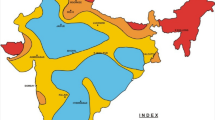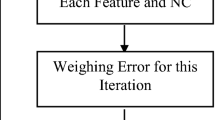Abstract
Potential seismic sources play an important role in seismic hazard analysis. Identification of seismic sources is generally carried out on the basis of expert judgments, and in most cases, different and controversial results are obtained when several experts are consulted. In fact, the method of source identification is probably an important cause of uncertainty in the seismic hazard analysis. The main objective of this research is to provide an algorithm which combines the weighted K-means clustering analysis and Particle Swarm Optimization in order to automatically identify global optimum clusters by analysing seismic event data. These clusters, together with seismotectonic information, can be used to determine seismic sources. Two validity indexes, Davies–Bouldin's measure and Chou–Su–Lai's measure (CS), are used to determine optimum number of clusters. Study area is located at the longitude of 46°–48° E and latitude of 34°–36° N that is considered as the most seismically active part of Zagros continental collision zone, which has experienced large and destructive earthquakes due to movements of Sahneh and Nahavand segments of Zagros Main Recent Fault. As a result, 7-cluster model which is identified on the basis of DB validity index seems to be suitable for the considered earthquake catalogue, despite some limitations in partitioning.






Similar content being viewed by others
References
Aki K (1979) Characterization of barriers on an earthquake fault. J Geophys Res Solid Earth 84(B11):6140–6148
Al Shalabi L, Shaaban Z, Kasasbeh B (2006) Data mining: a preprocessing engine. J Comput Sci 2(9):735–739
Ambraseys NN, Melville CP (1982) A history of Persian earthquakes. Cambridge University Press, Cambridge
Aminzadeh F, Chatterjee S (1984) Applications of clustering in exploration seismology. Geoexploration 23(1):147–159
Ansari A, Firuzi E, Etemadsaeed L (2015) Delineation of seismic sources in probabilistic seismic-hazard analysis using fuzzy cluster analysis and monte carlo simulation. Bull Seismol Soc Am 105(4):2174–2191
Baker C, Jackson J, Priestley K (1993) Earthquakes on the Kazerun Line in the Zagros Mountains of Iran: strike-slip faulting within a fold-and-thrust belt. Geophys J Int 115(1):41–61
Berberian M (1981) Active faulting and tectonics of Iran. In: Gupta HK, Delany FM (eds) Zagros-Hindukush-Himalaya Geodynamic evolution, Am. Geophys. Union and Geol. Soc Am, Geodyn. Ser 3: 33–69
Berberian M (1995) Master “blind” thrust faults hidden under the Zagros folds: active basement tectonics and surface morphotectonics. Tectonophysics 241(3–4):193–224
Burton PW, Hall TR (2014) Segmentation of the Sumatran fault. Geophys Res Lett 41(12):4149–4158
Calinski T, Harabasz J (1974) A dendrite method for cluster analysis. Commun Stat-Theory Methods 3(1):1–27
Chou CH, Su MC, Lai E (2004) A new cluster validity measure and its application to image compression. Pattern Anal Appl 7(2):205–220
Das S, Abraham A, Konar A (2007) Automatic clustering using an improved differential evolution algorithm. IEEE Trans Syst Man Cybern-Part A Syst Humans 38(1):218–237
Das S, Abraham A, Konar A (2009) Metaheuristic clustering. Springer, Berlin
Davies DL, Bouldin DW (1979) A cluster separation measure. IEEE Trans Pattern Anal Mach Intell 1(2):224–227
Dunn JC (1974) Well-separated clusters and optimal fuzzy partitions. J Cybern 4(1):95–104
Ebel JE, Kafka AL (1999) A Monte Carlo approach to seismic hazard analysis. Bull Seismol Soc Am 89(4):854–866
Eberhart R, Kennedy J (1995) A new optimizer using particle swarm theory. In MHS'95. Proceedings of the sixth international symposium on micro machine and human science, Nagoya, Japan. https://doi.org/10.1109/MHS.1995.494215
Frankel A (1995) Mapping seismic hazard in the central and eastern United States. Seismol Res Lett 66(4):8–21
Gutenberg B, Richter CF (1944) Frequency of earthquakes in California. Bull Seismol Soc Am 34(4):185–188
Halkidi M, Batistakis Y, Vazirgiannis M (2001) On clustering validation techniques. J Intell Inf Syst 17(2–3):107–145
Halkidi M, Vazirgiannis M (2001) Clustering validity assessment: Finding the optimal partitioning of a data set. In proceedings 2001 IEEE international conference on data mining, San Jose, CA, USA. https://doi.org/10.1109/ICDM.2001.989517
Hartigan JA, Wong MA (1979) Algorithm AS136: a K-means clustering Algorithm. J Royal Stat Soc 28(1):100–108
Helmstetter A, Kagan YY, Jackson DD (2007) High-resolution time-independent grid-based forecast for M≥ 5 earthquakes in California. Seismol Res Lett 78(1):78–86
Jackson JA (1980) Reactivation of basement faults and crustal shortening in orogenic belts. Nature 283(5745):343–346
Jackson J, Haines J, Holt W (1995) The accommodation of Arabia-Eurasia plate convergence in Iran. J Geophys Res Solid Earth 100(B8):15205–15219
Jackson J, McKenzie D (1984) Active tectonics of the Alpine-Himalayan Belt between western Turkey and Pakistan. Geophys J Int 77(1):185–264
Jain AK, Murty MN, Flynn PJ (1999) Data clustering: a review. ACM Comput Surv 31:264–322. https://doi.org/10.1145/331499.331504
MacQueen J (1967) Some methods for classification and analysis of multivariate observations. In Proceedings of the fifth Berkeley sym posium on mathematical statistics and probability 281–297. https://projecteuclid.org/euclid.bsmsp/1200512992
Manda K, Hanuman AS, Satapathy SC, Chaganti V, Babu AV (2010) A software tool for data clustering using particle swarm optimization. In international conference on swarm, evolutionary, and memetic computing. https://doi.org/10.1007/978-3-642-17563-3_34
Mirzaei N, Gao M, Chen YT (1999) Delineation of potential seismic sources for seismic zoning of Iran. J Seismolog 3(1):17–30
Mirzaei N, Gheitanchi MR (2002) Seismotectonics of Sahneh fault, middle segment of main recent fault, Zagros mountains, western Iran. J Earth Space Phys 28(2):1–8
Molnar P, Chen WP (1982) Seismicity and mountain building. In: Hsued KJ (ed) Mountain building processes. Academic Press, London, pp 41–57
Mousavi Bafrouei SH, Mirzaei N, Shabani E (2014a) A declustered earthquake catalog for the Iranian Plateau. Ann Geophys. https://doi.org/10.4401/ag-6395
Mousavi Bafrouie SH, Mirzaei N, Shabani E, Eskandari Ghadi M (2014b) Seismic hazard zoning in Iran and estimating peak ground acceleration in provincial capitals. J Earth Space Phys 40(4):15–38 (in Persian with English summary)
Omran MG, Engelbrecht AP, Salman A (2007) Dynamic clustering using particle swarm optimization with application in unsupervised image classification. Int J Comput Inf Eng 1(9):2898–2903
Omran MG, Engelbrecht AP, Salman A (2004) Image classification using particle swarm optimization. Recent Adv Simul Evol Learn. https://doi.org/10.1142/9789812561794_0019
Ouillon G, Ducorbier C, Sornette D (2008) Automatic reconstruction of fault networks from seismicity catalogs: Three-dimensional optimal anisotropic dynamic clustering. J Geophys Res Solid Earth. https://doi.org/10.1029/2007JB005032
Ouillon G, Sornette D (2011) Segmentation of fault networks determined from spatial clustering of earthquakes. J Geophys Res Solid Earth. https://doi.org/10.1029/2010JB007752
Ouyang Z, He J, Zhang K (2008) Data Mining for Seismic Exploration. In 2008 IEEE/WIC/ACM international conference on web intelligence and intelligent agent technology, Sydney, NSW, Australia. https://doi.org/10.1109/WIIAT.2008.161.
Pakhira MK, Bandyopadhyay S, Maulik U (2004) Validity index for crisp and fuzzy clusters. Pattern Recogn 37(3):487–501
Prabha K A, Visalakshi N K (2014) Improved particle swarm optimization based k-means clustering. In 2014 international conference on intelligent computing applications, Coimbatore, India. https://doi.org/10.1109/ICICA.2014.21
Rehman K, Burton PW, Weatherill GA (2014) K-means cluster analysis and seismicity partitioning for Pakistan. J Seismolog 18(3):401–419
Snyder DB, Barazangi M (1986) Deep crustal structure and flexure of the Arabian plate beneath the Zagros collisional mountain belt as inferred from gravity observations. Tectonics 5(3):361–373
Tchalenko JS, Braud J (1974) Seismicity and structure of the Zagros (Iran): the main recent fault between 33 and 35 N. Philosophical transactions of the royal society of London. Series A Math Phys Sci 277(1262):1–25
Tsai CW, Huang WC, Chiang MC (2014) Recent development of metaheuristics for clustering. In Mobile, Ubiquitous, and Intelligent Computing, Berlin, Heidelberg. https://doi.org/10.1007/978-3-642-40675-1-93
Theodoridis S, Koutroubas K (1999) Pattern recognition. Elsevier Academic Press, Amsterdam
Taroni M (2021) Back to the future: old methods for new estimation and test of the Gutenberg-Richter b-value for catalogues with variable completeness. Geophys J Int 224(1):337–339
Voronoi G, (1908a) Nouvelles applications des paramètres continus à la théorie des formes quadratiques. Premier mémoire. Sur quelques propriétés des formes quadratiques positives parfaites. Journal für die reine und angewandte Mathematik (Crelles Journal) 1908(133):97–102
Voronoi G, (1908b) Nouvelles applications des paramètres continus à la théorie des formes quadratiques. Deuxième mémoire. Recherches sur les parallélloèdres primitifs. Journal für die reine und angewandte Mathematik (Crelles Journal) 1908(134): 198–287
Wang X, Bai Y (2016) The global Minmax k-means algorithm. Springer plus 5(1):1–15
Weatherill G, Burton PW (2009) Delineation of shallow seismic source zones using K-means cluster analysis, with application to the Aegean region. Geophys J Int 176(2):565–588
Wells DL, Coppersmith KJ (1994) New empirical relationships among magnitude, rupture length, rupture width, rupture area, and surface displacement. Bull Seismol Soc Am 84(4):974–1002
Wiemer S (2001) A software package to analyze seismicity: ZMAP. Seismol Res Lett 72(3):373–382
Wiemer S, Wyss M (2000) Minimum magnitude of completeness in earthquake catalogs: examples from Alaska, the western United States, and Japan. Bull Seismol Soc Am 90(4):859–869
Wyss M, Hasegawa A, Wiemer S, Umino N (1999) Quantitative mapping of precursory seismic quiescence before the 1989, M 7.1 off-Sanriku earthquake, japan. Ann Geophys 42(5):851–869
Yuill RS (1971) The standard deviational ellipse; an updated tool for spatial description. Geografiska Annaler Series B Human Geography 53(1):28–39
Zhao M, Tang H, Guo J, Sun Y (2014) Data clustering using particle swarm optimization. In Future Information Technology, Berlin. https://doi.org/10.1007/978-3-642-55038-6_95
Acknowledgements
The authors greatly appreciate Editor and anonymous reviewers for their thorough comments and suggestions, which greatly helped improve the article.
Author information
Authors and Affiliations
Corresponding author
Ethics declarations
Conflict of interest
The authors declare that they have no conflict of interest.
Additional information
Communicated by Dr. Rodolfo Console (ASSOCIATE EDITOR) / Prof. Ramón Zúñiga (CO-EDITOR-IN-CHIEF).
Supplementary Information
Below is the link to the electronic supplementary material.
Rights and permissions
About this article
Cite this article
Sheikhhosseini, Z., Mirzaei, N., Heidari, R. et al. Delineation of potential seismic sources using weighted K-means cluster analysis and particle swarm optimization (PSO). Acta Geophys. 69, 2161–2172 (2021). https://doi.org/10.1007/s11600-021-00683-6
Received:
Accepted:
Published:
Issue Date:
DOI: https://doi.org/10.1007/s11600-021-00683-6




